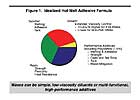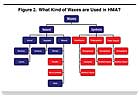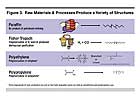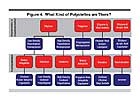Low-Molecular-Weight Polyolefins for Hot-Melt Adhesives
This
is the first of two articles addressing the role that low-molecular-weight
polyolefins and wax additives have in the formulation and performance of
hot-melt adhesives. This part examines wax additives available to the
formulator; their composition, characteristics, and manufacture; and general
information about their use. Part two will address specific characteristics of
various types of polyolefins and their role in hot-melt adhesives, including
formulation examples.
 Waxes, wax additives,
polyethylenes, and synthetic polyolefins are among the most versatile products
in the chemical industry, useful in diverse products and applications, and
widely used in hot-melt adhesives. Recent shifts in the raw-materials spectrum,
the availability of new base polymers for adhesive formulations and the advent
of new synthetic wax additives with targeted performance have resulted in new
formulation opportunities for hot-melt adhesives. In adhesive applications, A-C®
performance additives can improve strength, wetting and adhesion; modify the
open and set time; modify permanent tack; and provide antiblock performance and
rheology control.
Waxes, wax additives,
polyethylenes, and synthetic polyolefins are among the most versatile products
in the chemical industry, useful in diverse products and applications, and
widely used in hot-melt adhesives. Recent shifts in the raw-materials spectrum,
the availability of new base polymers for adhesive formulations and the advent
of new synthetic wax additives with targeted performance have resulted in new
formulation opportunities for hot-melt adhesives. In adhesive applications, A-C®
performance additives can improve strength, wetting and adhesion; modify the
open and set time; modify permanent tack; and provide antiblock performance and
rheology control.
An idealized hot-melt adhesive formulation is comprised of polymer, tackifier, diluent and performance additive (see Figure 1). The diluent may be one or more waxes, oils, plasticizers or processing aids. Such materials may include Fischer-Tropsch, paraffin or microcrystalline wax, polyolefin homopolymer or copolymer, polybutene, or napthenic process oil. Polyolefin homopolymers and copolymers, such as Honeywell’s A-C® polyolefins, are compatible with HMA components and may also offer synergistic improvements by reducing the migration of other adhesive components. Modified or functional polyolefins that have polar characteristics based upon their oxidation, copolymerization, or post-modification are particularly effective at low-use levels. Typically, a use level of 1-5% of an A-C performance additive can also be used to enhance wetting and adhesion, improve cohesive strength, provide rheology control, modify the set speed, and improve heat resistance. In summary, low-molecular-weight synthetic polyolefin waxes can be used as simple low-viscosity diluents or as multifunctional high-performance additives.
A typical wax is a solid at room temperature and can be hard or soft. All waxes will melt without decomposition above approximately 40°C. Wax characteristics include low viscosity above the melting point, low molecular weight, polishability with slight pressure, insolubility in water at room temperature, and crystallinity. The microarchitecture of a synthetic wax may be linear or branched, may include copolymers and modified polyolefins, and may be semi-crystalline imparting a high or a low density, dependent upon crystallinity.
 Waxes used in hot-melt
adhesives generally fall into two categories: naturally occurring or derived,
and synthetic or “man-made” (see Figure 2). Naturally occurring waxes include
animal, vegetable and mineral types, with the most common being the
microcrystalline and paraffin mineral types. Synthetic waxes are polyethylene,
polypropylene and Fischer-Tropsch. These waxes may be homopolymers, where the
polymer chain is based upon one monomer unit, such as ethylene, or they may be
copolymers based upon two or more units, such as ethylene and vinyl acetate.
Synthetic homopolymers or copolymers may also be functionalized in a
modification step. These modified polymer products form desirable adhesive
additives, as they often include polar and non-polar groups together on the
same molecule, which may work together in a formulation to enhance compatibility
and adhesion. The waxes highlighted in red in Figure 2 are the most common and
recognized as being useful in adhesives due to a combination of availability,
price, and performance.
Waxes used in hot-melt
adhesives generally fall into two categories: naturally occurring or derived,
and synthetic or “man-made” (see Figure 2). Naturally occurring waxes include
animal, vegetable and mineral types, with the most common being the
microcrystalline and paraffin mineral types. Synthetic waxes are polyethylene,
polypropylene and Fischer-Tropsch. These waxes may be homopolymers, where the
polymer chain is based upon one monomer unit, such as ethylene, or they may be
copolymers based upon two or more units, such as ethylene and vinyl acetate.
Synthetic homopolymers or copolymers may also be functionalized in a
modification step. These modified polymer products form desirable adhesive
additives, as they often include polar and non-polar groups together on the
same molecule, which may work together in a formulation to enhance compatibility
and adhesion. The waxes highlighted in red in Figure 2 are the most common and
recognized as being useful in adhesives due to a combination of availability,
price, and performance.
 While paraffin and a few
other wax raw materials used in the adhesives industry are byproducts of other
refining processes, other types included in Figure 3 are produced by synthesis,
or “on purpose,” to fit market needs. Molecular design of these raw materials
is optimized to meet specific market needs and is often enabled or restricted
by the type of manufacturing process used. The Fischer-Tropsch process relies
upon an iron or cobalt catalyst to convert carbon monoxide and hydrogen into a
mixture of hydrocarbon liquids, primarily for synthetic petroleum and wax. The
commercially viable processes for low-molecular-weight polyethylene include
high-pressure free radical, metallocene and Ziegler-Natta catalyzed
polymerization, which result in branched or linear polyethylenes of varied
microarchitecture. Depending upon the catalyst and process, a variety of
comonomers can be incorporated along the polymer chain, giving rise to a
variety of polyethylene copolymers useful in hot-melt adhesives. Some of the
polyethylene and polypropylene additives used in adhesives may arise from the
degradation of higher-molecular-weight polymers or as a byproduct of
high-molecular-weight olefin polymerization processes. These products can be
variable and may contain impurities, but do find use in lower-quality adhesives
where price is of paramount importance.
While paraffin and a few
other wax raw materials used in the adhesives industry are byproducts of other
refining processes, other types included in Figure 3 are produced by synthesis,
or “on purpose,” to fit market needs. Molecular design of these raw materials
is optimized to meet specific market needs and is often enabled or restricted
by the type of manufacturing process used. The Fischer-Tropsch process relies
upon an iron or cobalt catalyst to convert carbon monoxide and hydrogen into a
mixture of hydrocarbon liquids, primarily for synthetic petroleum and wax. The
commercially viable processes for low-molecular-weight polyethylene include
high-pressure free radical, metallocene and Ziegler-Natta catalyzed
polymerization, which result in branched or linear polyethylenes of varied
microarchitecture. Depending upon the catalyst and process, a variety of
comonomers can be incorporated along the polymer chain, giving rise to a
variety of polyethylene copolymers useful in hot-melt adhesives. Some of the
polyethylene and polypropylene additives used in adhesives may arise from the
degradation of higher-molecular-weight polymers or as a byproduct of
high-molecular-weight olefin polymerization processes. These products can be
variable and may contain impurities, but do find use in lower-quality adhesives
where price is of paramount importance.
Polymerization of ethylene to produce adhesive raw materials can result in either low- or high-density polyethylene of various molecular weights. The polymer molecular weight and branching control the resultant viscosity, rheology, and density of the material. Low-density polyethylene is branched and may have branches upon branches in a random distribution. High-density polyethylene is an essentially linear polyethylene structure.
Polymerization of propylene results in polypropylene homopolymer of various molecular weights dependent upon processing conditions. Polypropylene may be used as a homopolymer additive in HMA, or may be copolymerized or post-reacted to form functional materials that blend well and add desirable performance enhancements to the HMA due to their combination of hardness, heat resistance, and adhesive qualities.
One of the most important copolymers for use in adhesives is ethylene vinyl acetate (EVA), which is produced by the copolymerization of ethylene and vinyl acetate. Honeywell manufactures low-molecular-weight EVAs with different levels of vinyl acetate to provide compatibility with various adhesive formulations and promote adhesion to a variety of substrates. At very high vinyl acetate levels, the resulting copolymer can be especially useful in low-melt adhesives and can increase permanent tack in pressure-sensitive adhesives.
Another important ethylene copolymer for use in adhesives is ethylene acrylic acid (EAA), where ethylene and acrylic acid are copolymerized to form the EAA copolymer. Honeywell manufactures low-molecular-weight EAAs with different levels of acrylic acid to give excellent “stick and grab” and aggressive tack to difficult substrates while providing compatibility with a variety of adhesive formulations. In addition, at the highest acrylic acid levels, these materials are water-dispersible, thereby increasing their utility in certain applications.
One of the most effective functionalization routes for additives used in adhesives is oxidation. Homopolymers or copolymers may be oxidized to form molecules of increased polarity relative to their initial composition. The resultant oxidized molecule has a random distribution of polar functionality including acid, alcohol and ester groups, which are randomly placed along and at the end of the polymer chain. Oxidized polyolefin products, such as those in the A-C® line, include low-density polyethylene, high-density polyethylene and oxidized copolymers, such as oxidized ethylene vinyl acetate. Oxidized products are described by their acid number, a measure of their acid functionality that is reported in milligrams of potassium hydroxide required for neutralization per gram of product.
 Post functionalization of a
polyethylene or polypropylene homopolymer or copolymer with maleic anhydride is
useful in increasing the polar character of the hydrocarbon material, providing
greater adhesion and tack than the unmodified material. This increases adhesion
not only to polar surfaces such as steel, aluminum or glass, but also to
difficult surfaces such as vinyl, polypropylene, and other polyolefins.
Maleated polyolefins (MAPO) are typically characterized by their level of
maleic anhydride as measured by their saponification (SAP, or milligrams of
potassium hydroxide per gram of sample) number. However, the SAP number does
not adequately describe the effective amount of maleated polyolefin (i.e., the
amount of polyolefin grafted with maleic anhydride) because ungrafted maleic
anhydride oligomers that do not contribute to adhesion or compatibilization may
be present at significant levels. Honeywell’s process produces MAPO with high
percentages of “bound” maleic anhydride grafted to the polyolefin. Honeywell
manufactures an array of maleated polyethylenes and polypropylenes with a range
of maleic anhydride content, allowing for controlled adhesion promotion in HMA
formulations.
Post functionalization of a
polyethylene or polypropylene homopolymer or copolymer with maleic anhydride is
useful in increasing the polar character of the hydrocarbon material, providing
greater adhesion and tack than the unmodified material. This increases adhesion
not only to polar surfaces such as steel, aluminum or glass, but also to
difficult surfaces such as vinyl, polypropylene, and other polyolefins.
Maleated polyolefins (MAPO) are typically characterized by their level of
maleic anhydride as measured by their saponification (SAP, or milligrams of
potassium hydroxide per gram of sample) number. However, the SAP number does
not adequately describe the effective amount of maleated polyolefin (i.e., the
amount of polyolefin grafted with maleic anhydride) because ungrafted maleic
anhydride oligomers that do not contribute to adhesion or compatibilization may
be present at significant levels. Honeywell’s process produces MAPO with high
percentages of “bound” maleic anhydride grafted to the polyolefin. Honeywell
manufactures an array of maleated polyethylenes and polypropylenes with a range
of maleic anhydride content, allowing for controlled adhesion promotion in HMA
formulations.
Ionomers result from the metal salt neutralization of ethylene acrylic acid copolymers (EAA). Ionomeric additives can use any one of a variety of cations at various levels of acid neutralization. Thus, the acid functionality on the molecule may be partially neutralized, resulting in an ionomer still containing a level of acid functionality, or the cation may replace 100% of the acid functionalization resulting in a fully neutralized ionomer having no acid number. Honeywell’s AClyn® ionomers can function as low-molecular-weight analogs of ionomer polymers or as adhesion promoters in adhesive formulations.
In summary, the table in Figure 4 outlines the synthetic routes for polymerization and functionalization of polyolefins. The variety of A-C synthetic polyolefin additives available, combined with a variety of microarchitectural and polar structures, offer adhesive formulators many options. Why and how these materials should be selected for specific adhesive formulations will be discussed next month in the second part of this article.
For more information, contact Natalie Merrill, Honeywell International Inc., 101 Columbia Road, Morristown, NJ 07962; phone (973) 455-6309; e-mail Natalie.Merrill@Honeywell.com ; or visit www.honeywell.com/adhesives.
A-C® and AClyn® are registered trademarks of Honeywell International Inc.

An idealized hot-melt adhesive formulation is comprised of polymer, tackifier, diluent and performance additive (see Figure 1). The diluent may be one or more waxes, oils, plasticizers or processing aids. Such materials may include Fischer-Tropsch, paraffin or microcrystalline wax, polyolefin homopolymer or copolymer, polybutene, or napthenic process oil. Polyolefin homopolymers and copolymers, such as Honeywell’s A-C® polyolefins, are compatible with HMA components and may also offer synergistic improvements by reducing the migration of other adhesive components. Modified or functional polyolefins that have polar characteristics based upon their oxidation, copolymerization, or post-modification are particularly effective at low-use levels. Typically, a use level of 1-5% of an A-C performance additive can also be used to enhance wetting and adhesion, improve cohesive strength, provide rheology control, modify the set speed, and improve heat resistance. In summary, low-molecular-weight synthetic polyolefin waxes can be used as simple low-viscosity diluents or as multifunctional high-performance additives.
A typical wax is a solid at room temperature and can be hard or soft. All waxes will melt without decomposition above approximately 40°C. Wax characteristics include low viscosity above the melting point, low molecular weight, polishability with slight pressure, insolubility in water at room temperature, and crystallinity. The microarchitecture of a synthetic wax may be linear or branched, may include copolymers and modified polyolefins, and may be semi-crystalline imparting a high or a low density, dependent upon crystallinity.


Polymerization of ethylene to produce adhesive raw materials can result in either low- or high-density polyethylene of various molecular weights. The polymer molecular weight and branching control the resultant viscosity, rheology, and density of the material. Low-density polyethylene is branched and may have branches upon branches in a random distribution. High-density polyethylene is an essentially linear polyethylene structure.
Polymerization of propylene results in polypropylene homopolymer of various molecular weights dependent upon processing conditions. Polypropylene may be used as a homopolymer additive in HMA, or may be copolymerized or post-reacted to form functional materials that blend well and add desirable performance enhancements to the HMA due to their combination of hardness, heat resistance, and adhesive qualities.
One of the most important copolymers for use in adhesives is ethylene vinyl acetate (EVA), which is produced by the copolymerization of ethylene and vinyl acetate. Honeywell manufactures low-molecular-weight EVAs with different levels of vinyl acetate to provide compatibility with various adhesive formulations and promote adhesion to a variety of substrates. At very high vinyl acetate levels, the resulting copolymer can be especially useful in low-melt adhesives and can increase permanent tack in pressure-sensitive adhesives.
Another important ethylene copolymer for use in adhesives is ethylene acrylic acid (EAA), where ethylene and acrylic acid are copolymerized to form the EAA copolymer. Honeywell manufactures low-molecular-weight EAAs with different levels of acrylic acid to give excellent “stick and grab” and aggressive tack to difficult substrates while providing compatibility with a variety of adhesive formulations. In addition, at the highest acrylic acid levels, these materials are water-dispersible, thereby increasing their utility in certain applications.
One of the most effective functionalization routes for additives used in adhesives is oxidation. Homopolymers or copolymers may be oxidized to form molecules of increased polarity relative to their initial composition. The resultant oxidized molecule has a random distribution of polar functionality including acid, alcohol and ester groups, which are randomly placed along and at the end of the polymer chain. Oxidized polyolefin products, such as those in the A-C® line, include low-density polyethylene, high-density polyethylene and oxidized copolymers, such as oxidized ethylene vinyl acetate. Oxidized products are described by their acid number, a measure of their acid functionality that is reported in milligrams of potassium hydroxide required for neutralization per gram of product.

Ionomers result from the metal salt neutralization of ethylene acrylic acid copolymers (EAA). Ionomeric additives can use any one of a variety of cations at various levels of acid neutralization. Thus, the acid functionality on the molecule may be partially neutralized, resulting in an ionomer still containing a level of acid functionality, or the cation may replace 100% of the acid functionalization resulting in a fully neutralized ionomer having no acid number. Honeywell’s AClyn® ionomers can function as low-molecular-weight analogs of ionomer polymers or as adhesion promoters in adhesive formulations.
In summary, the table in Figure 4 outlines the synthetic routes for polymerization and functionalization of polyolefins. The variety of A-C synthetic polyolefin additives available, combined with a variety of microarchitectural and polar structures, offer adhesive formulators many options. Why and how these materials should be selected for specific adhesive formulations will be discussed next month in the second part of this article.
For more information, contact Natalie Merrill, Honeywell International Inc., 101 Columbia Road, Morristown, NJ 07962; phone (973) 455-6309; e-mail Natalie.Merrill@Honeywell.com ; or visit www.honeywell.com/adhesives.
A-C® and AClyn® are registered trademarks of Honeywell International Inc.
Links
Looking for a reprint of this article?
From high-res PDFs to custom plaques, order your copy today!



